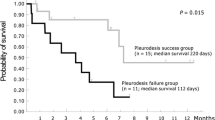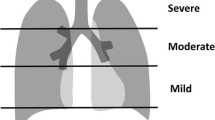Abstract
Malignant pleural effusion (PE) is a complication that often occurs in advanced cancer. The sensitivity of pleural fluid cytology is reported to vary from 30 to 90%; therefore, the process is less clinically practical in certain conditions. Thus, special biomarkers are needed to distinguish malignant PE and nonmalignant PE. The aim of this study is to compare the level of vascular endothelial growth factor-A (VEGF-A) in pleural fluid of patients with that in malignant and nonmalignant PE. Participants were divided into 2 groups: 19 patients with nonmalignant PE, and 34 patients with malignant PE. Both groups underwent pleural puncture procedures and were examined for VEGF-A levels. Statistical analysis was performed using the paired test or Mann–Whitney test. The ROC curve was employed to determine the VEGF-A cut-off value in malignant PE. The VEGF-A level in pleural fluid of malignant PE group was 1940.77 ± 1016.54 pg/mL, while the nonmalignant group was 178.16 ± 192.01 pg/mL (p < 0.001; 95% CI). The average VEGF-A level in malignant PE group with positive anatomic pathology results was 2036.69 ± 1008.15 pg/mL, and negative was 1855.51 ± 1045.35 pg/mL (p = 0.612; 95% CI). The cutoff value for VEGF-A level in pleural fluid for the diagnosis of malignant PE was 416.60 pg/mL with a sensitivity and specificity of 85.29% and 84.22% respectively. Examination of VEGF-A level in pleural fluid can be considered as a means of supporting the diagnosis of malignant PE.



Similar content being viewed by others
References
Asamura H (2010) Principles and practice of lung cancer. Lippincott Williams & Wilkins, Philadelphia
Thomas R, Kalomenidis I, Jett J, Lee YC (2016) Textbook of pleural diseases. Taylor & Francis
Haas AR, Sterman DH, Musani AI (2007) Malignant pleural effusions: management options with consideration of coding, billing, and a decision approach. Chest 132(3):1036–1041. https://doi.org/10.1378/chest.06-1757
Shu J, Sun G, Liu H, Liu J (2007) Clinical utility of vascular endothelial growth factor in diagnosing malignant pleural effusions. Acta Oncol 46(7):1004–1011
Spella M, Giannou AD, Stathopoulos GT (2015) Switching off malignant pleural effusion formation-fantasy or future? J Thorac Dis 7(6):1009–1020. https://doi.org/10.3978/j.issn.2072-1439.2015.05.20
Yano S, Shinohara H, Herbst RS, Kuniyasu H, Bucana CD, Ellis LM, Fidler IJ (2000) Production of experimental malignant pleural effusions is dependent on invasion of the pleura and expression of vascular endothelial growth factor/vascular permeability factor by human lung cancer cells. Am J Pathol 157(6):1893–1903. https://doi.org/10.1016/S0002-9440(10)64828-6
Jia L, Du Y, Li T, Lv Y, Wang Y, Zhang Y, Zhou X, Liu W (2015) Differential expression of vascular endothelial growth factor-A, -C and -D for the diagnosis and prognosis of cancer patients with malignant effusions. Oncol Lett 10(2):667–674. https://doi.org/10.3892/ol.2015.3305
Van Der Flier M, Coenjaerts F, Kimpen JL, Hoepelman AM, Geelen SP (2000) Streptococcus pneumoniae induces secretion of vascular endothelial growth factor by human neutrophils. Infect Immun 68(8):4792–4794. https://doi.org/10.1128/iai.68.8.4792-4794.2000
Matsuyama W, Hashiguchi T, Matsumuro K, Iwami F, Hirotsu Y, Kawabata M, Arimura K, Osame M (2000) Increased serum level of vascular endothelial growth factor in pulmonary tuberculosis. Am J Respir Crit Care Med 162(3):1120–1122
Fiorelli A, Vicidomini G, Di Domenico M, Napolitano F, Messina G, Morgillo F, Ciardiello F, Santini M (2011) Vascular endothelial growth factor in pleural fluid for differential diagnosis of benign and malignant origin and its clinical applications. Interact Cardiovasc Thorac Surg 12(3):420–424. https://doi.org/10.1510/icvts.2010.250357
Koniari I, Koletti B, Apostolakis E (2011) Vascular endothelial growth factor with tumour growth factor-beta, endostatin, proteinases or cytokines might be useful for differential diagnosis of pleural effusions. Interact Cardiovasc Thorac Surg 12(3):424–425. https://doi.org/10.1510/icvts.2010.250357A
Merinda V, Soegiarto G, Wulandari L (2020) T790M mutations identified by circulating tumor DNA test in lung adenocarcinoma patients who progressed on first-line epidermal growth factor receptor-tyrosine kinase inhibitors. Lung India 37(1):13–18. https://doi.org/10.4103/lungindia.lungindia_182_19
Wulandari L, Soegiarto G, Febriani A, Fatmawati F, Sahrun (2020) Comparison of detection of epidermal growth factor receptor (EFGR) gene mutation in peripheral blood plasma (liquid biopsy) with cytological specimens in lung adenocarcinoma patients. Indian J Surg Oncol. https://doi.org/10.1007/s13193-020-01046-1
Kalifatidis A, Lazaridis G, Baka S, Mpoukovinas I, Karavasilis V, Kioumis I, Pitsiou G, Papaiwannou A, Karavergou A, Tsakiridis K (2015) Thoracocentesis: from bench to bed. J Thorac Dis 7(1):S1–S4
Cao W, Wang Y, Zhou N, Xu B (2016) Efficacy of ultrasound-guided thoracentesis catheter drainage for pleural effusion. Oncol Lett 12(6):4445–4448
Gupta PK, Prabhakar S, Sharma S, Anand A (2011) Vascular endothelial growth factor-a (VEGF-A) and chemokine ligand-2 (CCL2) in amyotrophic lateral sclerosis (ALS) patients. J Neuroinflammation 8(1):47
Kim H-R, Kim B-R, Park R-K, Yoon K-H, Jeong E-T, Hwang K-E (2017) Diagnostic significance of measuring vascular endothelial growth factor for the differentiation between malignant and tuberculous pleural effusion. Tohoku J Exp Med 242(2):137–142. https://doi.org/10.1620/tjem.242.137
Wu S-G, Yu C-J, Tsai M-F, Liao W-Y, Yang C-H, Jan I-S, Yang P-C, Shih J-Y (2013) Survival of lung adenocarcinoma patients with malignant pleural effusion. Eur Respir J 41(6):1409–1418
Light RW (2007) Pleural diseases. 5 edn. Lippincott Williams & Wilkins
Porcel JM, Vives M (2003) Differentiating tuberculous from malignant pleural effusions: a scoring model. Med Sci Monit 9(5):CR175–CR180
Takahashi S (2011) Vascular endothelial growth factor (VEGF), VEGF receptors and their inhibitors for antiangiogenic tumor therapy. Biol Pharm Bull 34(12):1785–1788. https://doi.org/10.1248/bpb.34.1785
Shivakumarswamy U, Arakeri SU, Karigowdar MH, Yelikar B (2012) Diagnostic utility of the cell block method versus the conventional smear study in pleural fluid cytology. J Cytol 29(1):11–15. https://doi.org/10.4103/0970-9371.93210
Chen Y, Mathy NW, Lu H (2018) The role of VEGF in the diagnosis and treatment of malignant pleural effusion in patients with non-small cell lung cancer (review). Mol Med Rep 17(6):8019–8030. https://doi.org/10.3892/mmr.2018.8922
Zhou WB, Bai M, Jin Y (2009) Diagnostic value of vascular endothelial growth factor and endostatin in malignant pleural effusions. Int J Tuberc Lung Dis 13(3):381–386
Porcel JM (2013) Identifying transudates misclassified by Light’s criteria. Curr Opin Pulm Med 19(4):362–367. https://doi.org/10.1097/MCP.0b013e32836022dc
Acknowledgments
We thank Ms. Rossellini Ngiono B. Sc for her dedicated time to review and proofread our manuscript.
Author information
Authors and Affiliations
Contributions
All authors contributed toward data analysis, drafting and revising the paper, gave final approval of the version to be published and agree to be accountable for all aspects of the work.
Corresponding author
Ethics declarations
Conflict of Interest
The authors declare that they have no conflict of interest.
Additional information
Publisher’s Note
Springer Nature remains neutral with regard to jurisdictional claims in published maps and institutional affiliations.
Rights and permissions
About this article
Cite this article
Hariyanto, W., Wulandari, L., Pradjoko, I. et al. Comparison of Vascular Endothelial Growth Factor-A (VEGF-A) Level in Pleural Fluid of Patients with Malignant and Nonmalignant Pleural Effusion. Indian J Surg 83, 132–138 (2021). https://doi.org/10.1007/s12262-020-02204-z
Received:
Accepted:
Published:
Issue Date:
DOI: https://doi.org/10.1007/s12262-020-02204-z




